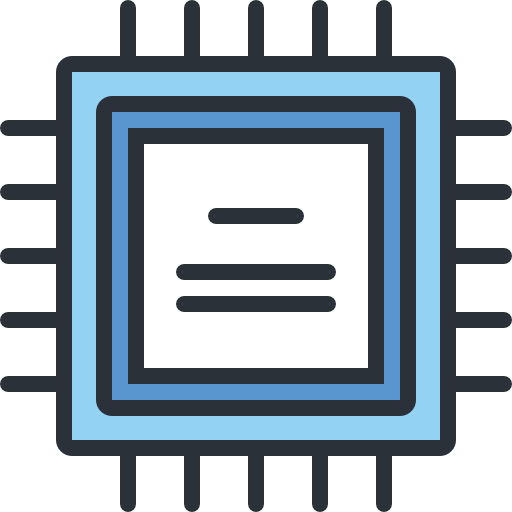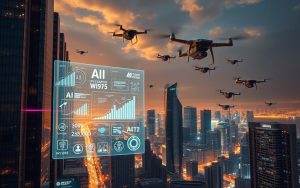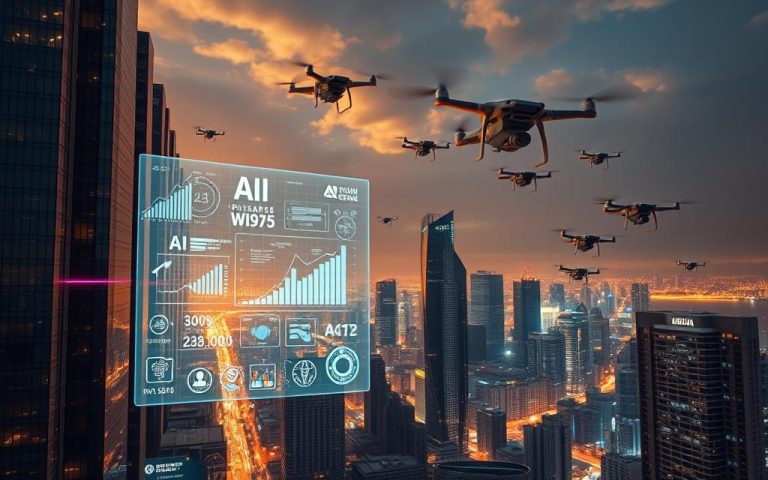How Businesses Leverage AI for Growth & Efficiency
Modern enterprises increasingly rely on artificial intelligence to drive innovation and streamline operations. From retail to healthcare, these technologies transform how companies analyze data, automate tasks, and enhance decision-making.
The global AI market expands rapidly, projected to grow at 40.2% annually. Over 80% of firms now actively explore AI solutions, with 84% of executives linking them to strategic growth. This adoption fuels measurable gains, like 20-50% fewer supply chain errors.
Real-world examples abound. Netflix personalizes content using clustering algorithms, while Walmart optimizes inventory with predictive analytics. Such applications prove AI’s versatility across industries, making it indispensable for competitive business success today.
What Is Artificial Intelligence in Business?
Advanced systems now replicate human decision-making through data-driven insights. These technologies analyze patterns, adapt to new information, and execute tasks with minimal human intervention. Unlike static programs, they evolve over time.
Defining AI and Its Core Technologies
Machine learning forms the backbone of modern AI. Algorithms process vast datasets to predict outcomes, like Netflix’s personalized recommendations. This self-improving capability sets it apart from rigid, rule-based software.
Natural language processing enables chatbots like ChatGPT to understand queries in plain English. Voice assistants like Siri rely on NLP to interpret commands and respond naturally.
Robotic process automation streamlines repetitive tasks. GE’s warehouses use RPA to manage inventory 30% faster. Meanwhile, generative AI crafts marketing copy or designs, boosting creativity without human input.
How AI Differs from Traditional Software
Legacy systems follow predefined rules. AI learns from data, adjusting its processes dynamically. Salesforce’s Einstein AI, for example, refines sales forecasts as new deal data emerges.
MIT research highlights AI’s role as a collaborator, not just a replacement tool. It augments human intelligence by handling complex analytics, freeing teams for strategic work. Explore more on AI-driven automation in enterprise settings.
How Is Artificial Intelligence Used in a Business Environment?
Enterprises now deploy AI-driven solutions to enhance operations and customer interactions. These technologies address pain points across departments, delivering measurable efficiency gains.

Revolutionizing Customer Support
Chatbots like boost.ai handle 70% of queries without human agents. They slash resolution times by 40%, offering 24/7 support. Cost savings reach millions annually, as seen with Bank of America’s Erica.
Data-Driven Decision Making
Predictive *analytics* tools, such as IBM Watson, parse vast datasets to forecast trends. Manufacturers reduce downtime by 12% through AI-powered maintenance alerts. Sentiment analysis tracks 10M+ social mentions daily, refining brand strategies.
Optimizing Logistics
Walmart’s AI predicts demand spikes, cutting overstock by 20%. Blue Yonder’s platform prevents disruptions by analyzing weather and shipping data. Machine learning dynamically reroutes deliveries, saving fuel and time.
Targeted Marketing Campaigns
Netflix’s recommendation engine drives 35% of sales via personalized suggestions. Adobe’s attribution models map customer journeys, boosting ad ROI by 22%. Programmatic platforms like Google Smart Compose auto-optimize bids.
| AI Tool | Application | Impact |
|---|---|---|
| boost.ai | Chatbots | 70% query resolution |
| Blue Yonder | Supply Chain | 20% waste reduction |
| Salesforce Einstein | Marketing | 22% higher ROI |
Fraud detection systems, like Mastercard’s, save $15B yearly. These examples underscore AI’s versatility in solving real-world challenges.
Top Benefits of AI for Business Growth
Strategic AI adoption unlocks productivity and customer satisfaction. Firms report 25% higher salaries after implementation, while 71% of employees trust ethical use cases. Société Générale’s digital transformation showcases scalable processes.
Boosting Operational Efficiency
AI slashes costs and accelerates workflows. UPS’s ORION system saves 10M gallons of fuel yearly by optimizing routes. Data processing speeds jump 40%, while ML forecasting cuts inventory expenses by 30%.
Legal teams automate 50% of document reviews. Unilever reduced hiring time by 75% using AI recruitment tools. These operations gains free teams for high-value tasks.
Enhancing Customer Experiences
Personalization drives loyalty. AI-powered recommendations boost NPS scores by 68%. Sentiment analysis tracks 10M+ social mentions to refine customer strategy.
Chatbots resolve 40% of support queries instantly. Amazon’s cross-selling engine generates 35% of revenue. Real-time insights enable hyper-targeted campaigns.
| Area | AI Solution | Impact |
|---|---|---|
| Operations | UPS ORION | 10M gallons fuel saved |
| Customer Service | AI Chatbots | 40% faster resolutions |
| Marketing | Amazon Recommendations | 35% revenue increase |
Accenture projects AI could add $4T to the global economy. These tools transform business models, blending efficiency with unparalleled engagement.
Challenges and Ethical Considerations of AI Adoption
AI adoption presents complex hurdles alongside its transformative potential. While *algorithms* drive efficiency, they also introduce security vulnerabilities and societal impacts. Proactive management is essential to balance innovation with accountability.

Data Privacy and Security Risks
Healthcare breaches exposed 45M patient data records last year, highlighting systemic vulnerabilities. Biden’s 2023 Executive Order mandates ethical audits to curb discrimination *risk* in hiring tools.
EU’s AI Act requires US firms to document data usage. Non-compliance risks fines up to 6% of global revenue. Microsoft reports 67% of SMBs lack protocols for AI security.
Workforce Transformation and Skill Gaps
IMF warns 40% of jobs face AI disruption. Amazon’s recruiting tool, scrapped for gender bias, underscores the need for inclusive *algorithms*. PwC finds 74% of firms now retrain staff to bridge skill gaps.
IBM’s $2B initiative upskills the workforce in AI literacy. Yet, 3.5M cybersecurity roles remain unfilled globally. MIT’s collaboration frameworks show humans and AI thrive as partners, not rivals.
“Reskilling isn’t optional—it’s a strategic imperative for AI readiness.”
The Future of AI in Business
Next-generation solutions push boundaries in operational efficiency and innovation. By 2026, 25 million users will leverage agentic AI, while the AIOps market surges to $19 billion. These advancements redefine how *industries* optimize workflows and decision-making.

Emerging Trends: Agentic AI and Autonomous Systems
Autonomous supply chains could slash lead times by 40%. Boston Dynamics’ warehouse robots already collaborate with staff, blending human agility with machine precision. NVIDIA’s Omniverse creates digital twins for real-time *analytics*.
Generative AI accelerates pharmaceutical R&D, trimming discovery phases by months. Gartner predicts 30% of enterprises will employ AI architects by 2027. Microsoft’s OpenAI partnership democratizes access, fueling small-business adoption.
Collaboration Between Humans and AI
AI-augmented coding tools boost developer output tenfold. Climate modeling *technology* helps firms track emissions and meet sustainability goals. Workers increasingly partner with AI for creative *tasks*, like drafting marketing campaigns.
“Autonomous systems will handle 45% of repetitive *tasks* by 2025, freeing teams for strategic work.”
As *technologies* evolve, ethical frameworks ensure transparency. The *future* hinges on balancing *potential* with accountability, ensuring AI serves as a force multiplier.
Conclusion
Forward-thinking companies gain a competitive edge by embracing AI-driven solutions. Wharton reports a 300% spike in AI course enrollments, while 60% of SMBs prioritize hiring AI-skilled talent.
From pilot programs to full-scale deployment, early adopters see 83% higher revenue. Audit workflows, upskill teams, and collaborate with experts to unlock potential.
Delay risks obsolescence—65% of lagging firms may falter by 2028. Build a strategy today to harness AI’s transformative power. Start your roadmap now.













